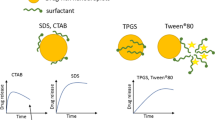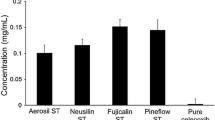Abstract
Surfactants are commonly incorporated in conventional and enabled formulations to enhance the rate and extent of dissolution of drugs exhibiting poor aqueous solubility. Generally the interactions between the drug and excipients are systematically evaluated, however, limited attention is paid towards understanding the effect of interaction between functional excipients and its impact on the performance of the product. In the current study, the effect of potential interaction between a nonionic polymer binder, povidone, and anionic surfactant docusate sodium on the rate and extent of dissolution of a drug exhibiting poor aqueous solubility was evaluated by varying the proportions of the binder and the surfactant in the formulation. Potential complexation or aggregation between the excipients was investigated by fluorescence spectroscopy and zeta potential measurements of the aqueous solutions of docusate sodium, povidone, and sodium lauryl sulfate (SLS). The rate and extent of drug release was found to decrease with an increase in the proportion of docusate sodium and povidone in the formulations. Difference in magnitude of surface charge (zeta potential) of docusate sodium in presence of povidone indicated potential surfactant-polymer aggregation during dissolution which was corroborated by CAC/CMC values derived from fluorescence spectroscopic measurements. The decrease in the rate of drug release was attributed to an increase in the viscosity of the microenvironment of dissolving particles due to the interaction of docusate sodium and povidone in the aqueous media during dissolution. These findings highlight the importance of systematic evaluation of the interaction of ionic surfactants with the polymeric components within the formulation to ensure the appropriate selection of the type of surfactant as well as its proportion in the formulation.





Similar content being viewed by others
Abbreviations
- SLS Sodium lauryl sulfate:
-
PVP Polyvinylpyrrolidone
DS Docusate sodium
References
Reddy RK, Khalil SA, Wafik Gouda M. Effect of dioctyl sodium sulfosuccinate and poloxamer 188 on dissolution and intestinal absorption of sulfadiazine and sulfisoxazole in rats. J Pharm Sci. 1976;65(1):115–8.
Sjökvist E, Nyström C, Aldén M, Caram-Lelham N. Physicochemical aspects of drug release. XIV. The effects of some ionic and non-ionic surfactants on properties of a sparingly soluble drug in solid dispersions. Int J Pharm. 1992;79(1):123–33.
Brown S, Rowley G, Pearson JT. Surface treatment of the hydrophobic drug danazol to improve drug dissolution. Int J Pharm. 1998;165(2):227–37.
Serajuddin ATM, Sheen PC, Augustine MA. Improved dissolution of a poorly water-soluble drug from solid dispersions in polyethylene glycol: Polysorbate 80 mixtures. J Pharm Sci. 1990;79(5):463–4.
Wong SM, Kellaway IW, Murdan S. Enhancement of the dissolution rate and oral absorption of a poorly water soluble drug by formation of surfactant-containing microparticles. Int J Pharm. 2006;317(1):61–8.
Per F, Sissel S. Dissolution kinetics of drugs in human gastric juice—the role of surface tension. J Pharm Sci. 1968;57(8):1322–6.
Milo G, Stuart F. Mechanisms of surfactant effects on drug absorption. J Pharm Sci. 1970;59(5):579–89.
Patel HJ, Parikh VP. An overview of osmotic drug delivery system: an update review. Int J Bioassays. 2017;6(7):5426–36.
Shah SH, Patel VR, Shah VR, Vaghani ZH, Thakkar AY. Nanotechnology: a review on revolution in cancer treatment. Pharm Rev. 2008;6(6).
Gumaste SG, Gupta SS, Serajuddin ATM. Investigation of polymer-surfactant and polymer-drug-surfactant miscibility for solid dispersion. AAPS J. 2016;18(5):1131–43.
Shah VP, Konecny JJ, Everett RL, McCullough B, Noorizadeh AC, Skelly JP. In vitro dissolution profile of water-insoluble drug dosage forms in the presence of surfactants. Pharm Res. 1989;6(7):612–8.
Ofner CM, Zhang YE, Jobeck VC, Bowman BJ. Crosslinking studies in gelatin capsules treated with formaldehyde and in capsules exposed to elevated temperature and humidity. J Pharm Sci. 2001;90(1):79–88.
Digenis GA, Gold TB, Shah VP. Cross-linking of gelatin capsules and its relevance to their in vitro-in vivo performance. J Pharm Sci. 1994;83(7):915–21.
Cole ET. Liquid-filled and sealed hard gelatin capsule technologies. In: Rathbone MJ, Hadgraft J, editors. Modified-release drug delivery technology. Boca Raton: CRC Press; 2002. p. 177–90.
Nilsson S. Interactions between water-soluble cellulose derivatives and surfactants. 1. The HPMC/SDS/water system. Macromolecules. 1995;28(23):7837–44.
Azum N, Asiri AM, Rub MA, Al-Youbi AO, Khan A. Thermodynamic aspects of polymer–surfactant interactions: Gemini (16-5-16)-PVP-water system. Arab J Chem. 2016;9:S1660–S4.
Holmberg C, Nilsson S, Sundelöf L-O. Thermodynamic properties of surfactant/polymer/water systems with respect to clustering adsorption and intermolecular interaction as a function of temperature and polymer concentration. Langmuir. 1997;13(6):1392–9.
Kumar N, Tyagi R. Analysis of the interactions of polyvinylpyrrolidone with conventional anionic and dimeric anionic surfactant. J Dispers Sci Technol. 2015;36(11):1601–6.
Qi S, Roser S, Edler KJ, Pigliacelli C, Rogerson M, Weuts I, et al. Insights into the role of polymer-surfactant complexes in drug solubilisation/stabilisation during drug release from solid dispersions. Pharm Res. 2013;30(1):290–302.
de Martins RM, Silva CA, Becker C, Samios D, Bica CID, Christoff M. Studies on anionic surfactant structure in the aggregation with (hydroxypropyl)cellulose. Polimeros. 2002;12:109–14.
Goddard ED. Polymer—surfactant interaction part I. Uncharged water-soluble polymers and charged surfactants. Colloids Surf. 1986;19(2):255–300.
Ghebremeskel AN, Vemavarapu C, Lodaya M. Use of surfactants as plasticizers in preparing solid dispersions of poorly soluble API: selection of polymer–surfactant combinations using solubility parameters and testing the processability. Int J Pharm. 2007;328(2):119–29.
Deshpande TM, Shi H, Pietryka J, Hoag SW, Medek A. Investigation of polymer/surfactant interactions and their impact on itraconazole solubility and precipitation kinetics for developing spray-dried amorphous solid dispersions. Mol Pharm. 2018;15(3):962–74.
Goddard ED, Turro NJ, Kuo PL, Ananthapadmanabhan KP. Fluorescence probes for critical micelle concentration determination. Langmuir. 1985;1(3):352–5.
Shah VR, Gupta PK. Structural stability of recombinant human growth hormone (r-hgh) as a function of polymer surface properties. Pharm Res. 2018;35(5):98.
Sawant RR, Sawant RM, Torchilin VP. Mixed PEG–PE/vitamin E tumor-targeted immunomicelles as carriers for poorly soluble anti-cancer drugs: improved drug solubilization and enhanced in vitro cytotoxicity. Eur J Pharm Biopharm. 2008;70(1):51–7.
La SB, Okano T, Kataoka K. Preparation and characterization of the micelle-forming polymeric drug indomethacin-incorporated polyfethylene oxide)-poly(β-benzyl l-aspartate) block copolymer micelles. J Pharm Sci. 1996;85(1):85–90.
White B, Banerjee S, O'Brien S, Turro NJ, Herman IP. Zeta-potential measurements of surfactant-wrapped individual single-walled carbon nanotubes. J Phys Chem C. 2007;111(37):13684–90.
US FDA. Inactive ingredient search for approved drug products 2018 [cited 2018 5/1/2018]. Available from: http://www.accessdata.fda.gov/scripts/cder/iig/.
Chambliss WG, Cleary RW, Fischer R, Jones AB, Skierkowski P, Nicholes W, et al. Effect of docusate sodium on drug release from a controlled-release dosage form. J Pharm Sci. 1981;70(11):1248–51.
Aguiar J, Carpena P, Molina-Bolı́var JA, Carnero Ruiz C. On the determination of the critical micelle concentration by the pyrene 1:3 ratio method. J Colloid Interface Sci. 2003;258(1):116–22.
Bhattacharjee S. DLS and zeta potential – what they are and what they are not? J Control Release. 2016;235:337–51.
Author information
Authors and Affiliations
Corresponding author
Rights and permissions
About this article
Cite this article
Parikh, V., Gumaste, S.G. & Phadke, S. Effect of the Interaction Between an Ionic Surfactant and Polymer on the Dissolution of a Poorly Soluble Drug. AAPS PharmSciTech 19, 3040–3047 (2018). https://doi.org/10.1208/s12249-018-1125-x
Received:
Accepted:
Published:
Issue Date:
DOI: https://doi.org/10.1208/s12249-018-1125-x




